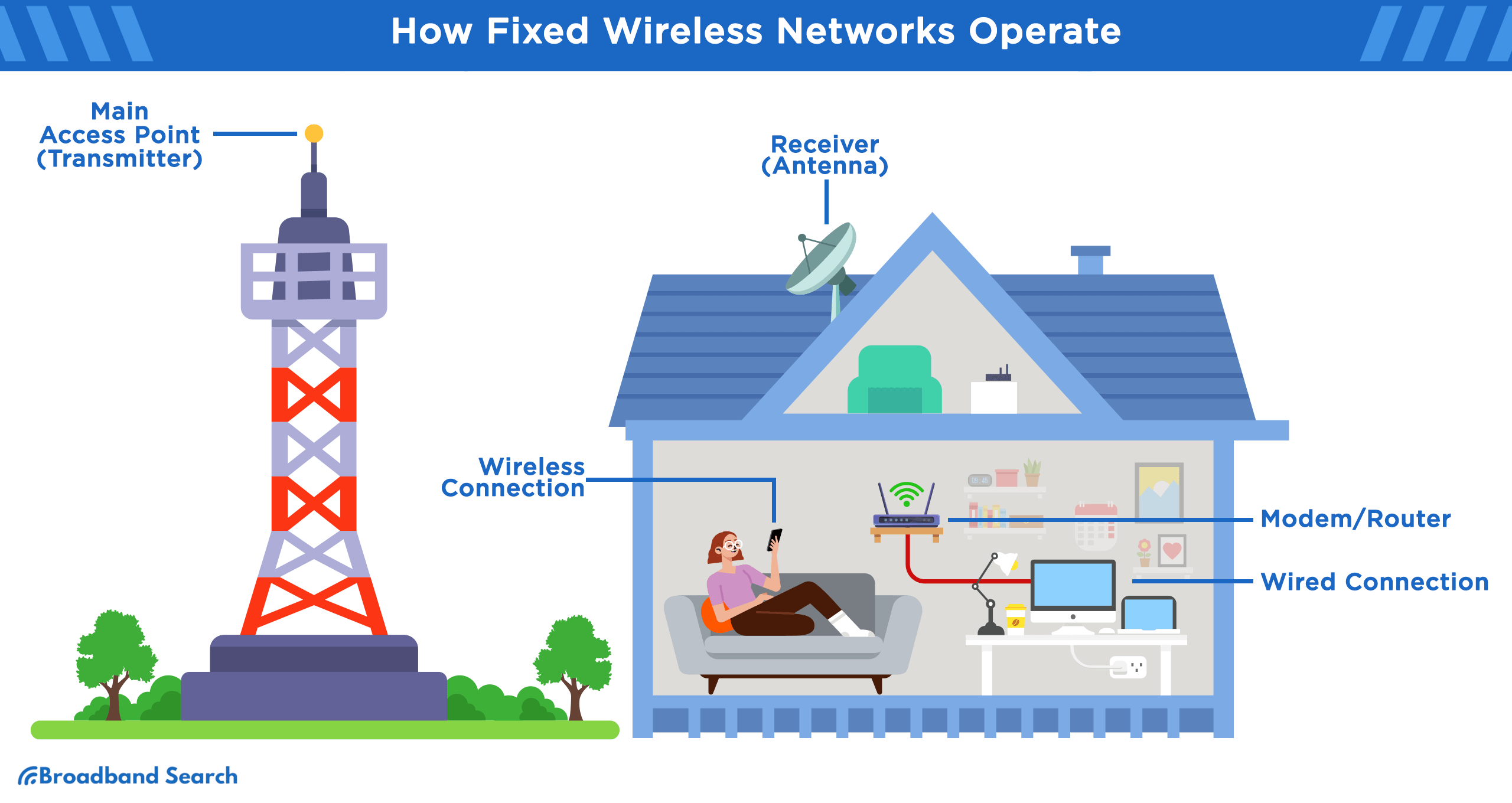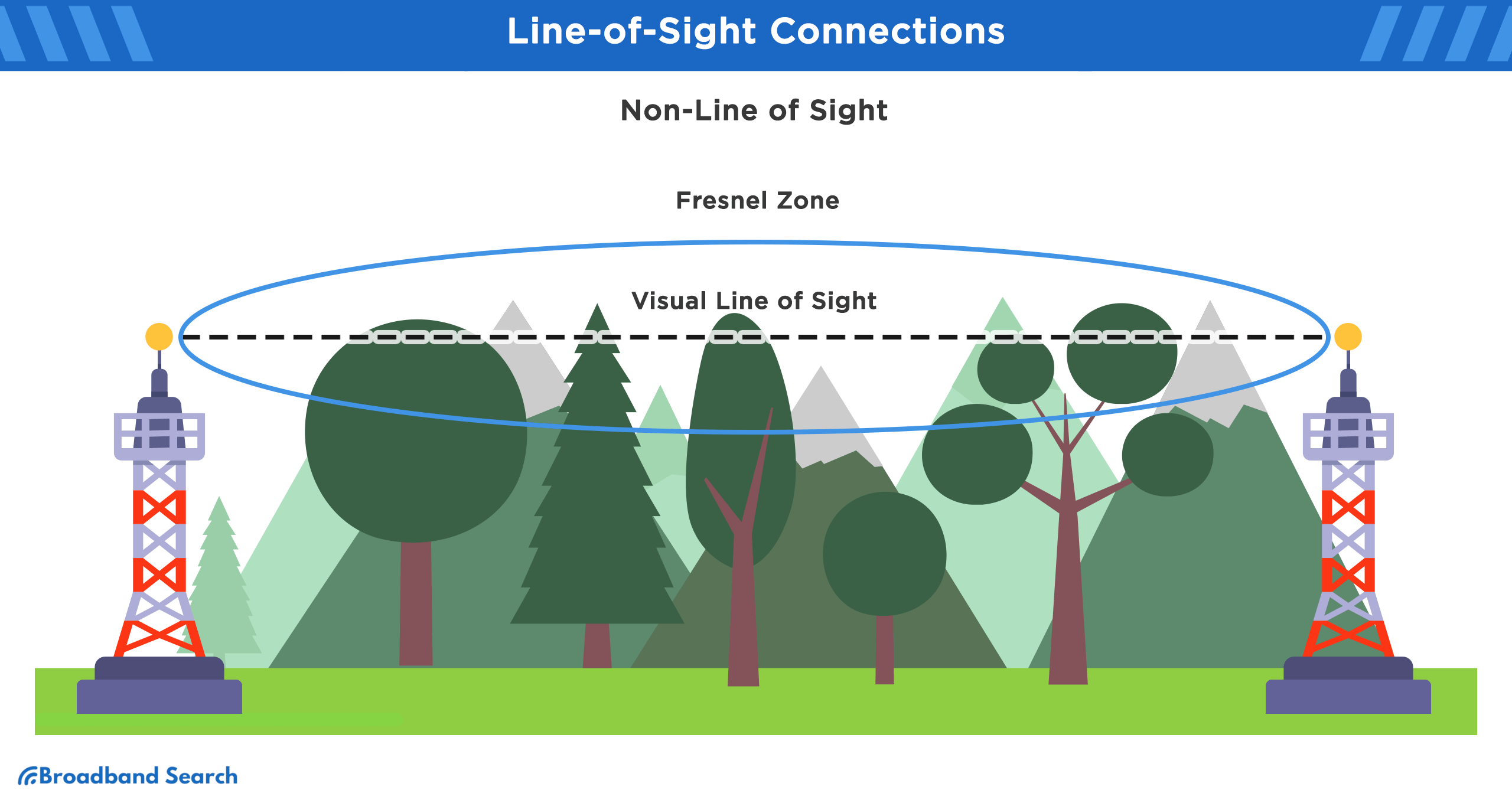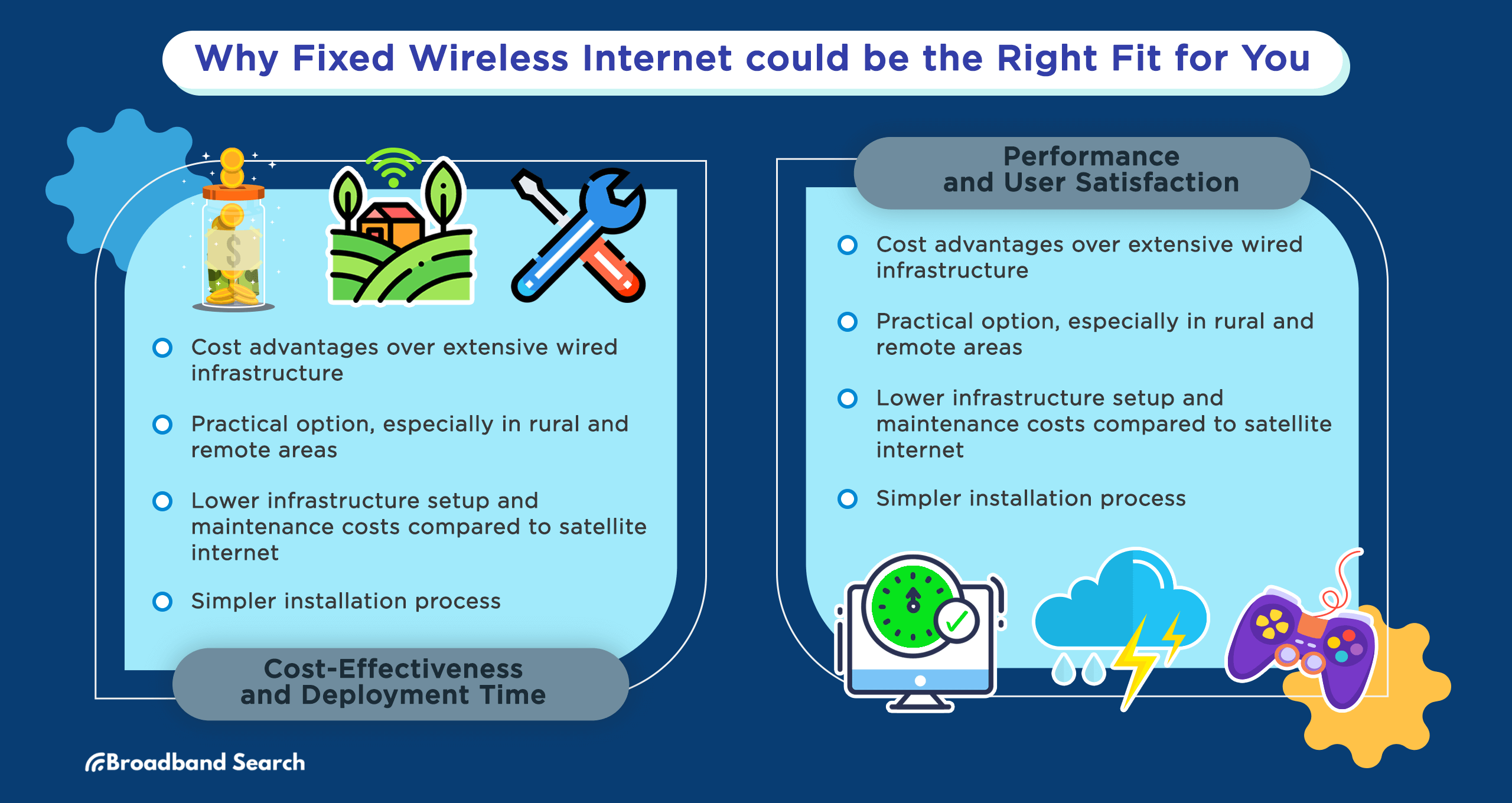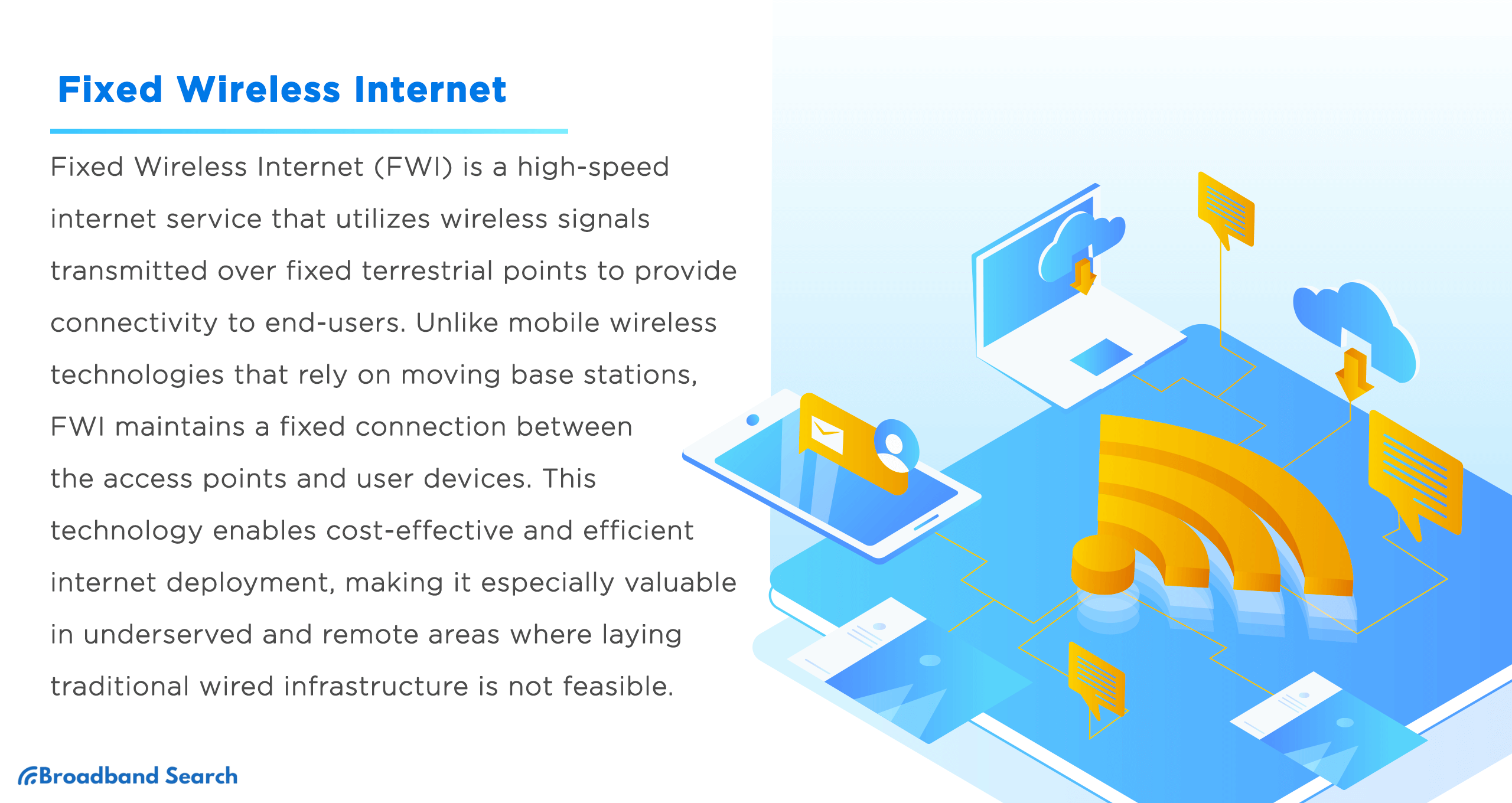Fixed wireless internet (FWA) is a home broadband connection that delivers internet service over radio or cellular signals from a nearby tower to a receiver at your home instead of cables. Most modern fixed wireless plans deliver around 100–400+ Mbps download speed with 20–50 ms latency, enough for streaming, video calls, and remote work. It’s useful for homes that don’t yet have fiber-optic internet or modern cable but have strong 4G/5G coverage or a clear line of sight to a local wireless internet service provider (WISP) tower.
| Metric | Typical Performance | Notes |
|---|---|---|
| Download Speeds | 100–400+ Mbps | Varies significantly by location and network traffic. |
| Upload Speeds | 10–50 Mbps | Lower than fiber, but sufficient for most needs. |
| Latency | 20-50 ms | Dependent on signal quality and network congestion. |
| Install Time | Same or next day | Simple self-installation makes it easy to get online. |
These ranges vary by provider and location.
Key Takeaways: Fixed Wireless Internet
- Most 5G-based fixed wireless plans deliver 100–400+ Mbps downloads in areas with strong signal acquisition.
- Typical internet latency is around 20–50 ms, which works for streaming, calls, and casual gaming.
- Installation is fast and often self-installed; proper gateway placement and line of sight are critical.
- Check for deprioritization (speed throttling) thresholds, data policies, and CGNAT limits if you host services or use advanced networking.

How Does Fixed Wireless Internet Work?
Fixed wireless internet works by establishing a wireless link (either cellular or radio) between an antenna or gateway at your home and a nearby tower operated by a provider like T-Mobile or Verizon, as well as smaller regional wireless internet service providers (WISP).
From the Tower to Your Home
- Provider Tower or Base Station: The process begins at a central tower, which broadcasts the internet signal over licensed or unlicensed spectrum.
- Backhaul (Behind the Scenes): This tower is connected to the wider internet backbone via high-capacity links, typically a fiber-optic or high-speed microwave backhaul.
- Customer Premises Equipment (CPE) / Gateway: A small receiver unit or indoor gateway is installed at your home and aimed directly at the tower. This device receives the signals and distributes the internet connection via Wi-Fi or Ethernet.
- Point-to-Multipoint: A single tower or base station can serve many homes, with each home establishing its own unique radio link to the tower.
Fixed Wireless Internet Operating Spectrums
Depending on the type of fixed wireless, signals are transmitted over one of the following spectrums:
Low-Band (600–900 MHz):
- Offers the longest reach and best building penetration.
- Provides lower top speeds.
- Commonly used in rural and cellular-based FWA links.
Mid-Band (1–6 GHz):
- Provides the best balance of range and speed.
- It is the core band for many 5G home internet deployments and WISPs.
- Examples include 2.5 GHz, 3.5 GHz (CBRS), and C-band (3.7–3.98 GHz).
High-Band (mmWave) (~24–40 GHz+):
- Delivers high speeds but has a very short range.
- Requires a clear line of sight and is sensitive to obstructions and heavy rain.
- Used in select urban areas and for short links.
Unlicensed Bands (e.g., 5 GHz, 6 GHz, 60 GHz):
- Cost-effective and quick to deploy.
- Can face interference in crowded areas.
- Used by some WISPs for short point-to-point connections.
Licensed Bands:
- Providers have exclusive rights to this spectrum, reducing interference and improving consistency.
- Used by major carriers for their 5G networks and licensed WISP links.
What Affects Fixed Wireless Performance
Fixed wireless isn’t without its drawbacks and is susceptible to signal degradation. Here is a breakdown of factors that can affect fixed wireless performance:
- Signal Quality & Distance: Performance is tied to how close you are to the cellular tower and to having a clear line of sight.
- Obstructions: Physical barriers such as trees, hills, and buildings can weaken or block signals, particularly those at higher frequencies.
- Network Load: Because towers are shared infrastructure, speeds can dip noticeably during busy times due to congestion.
- Weather: While lower-frequency bands are resilient, heavy rain and severe weather can affect higher-frequency spectrums, leading to slowdowns or outages.
- Gateway Placement: Placing the indoor gateway by a window that faces the tower, or using an external outdoor antenna, can noticeably improve your results.

Fixed Wireless Equipment & Installation
- Self-Install (5G home internet): Users can easily set up an indoor gateway by finding the best view of the tower and following prompts in the provider’s app.
- Professional Install (WISPs): A technician mounts and installs a small outdoor antenna, runs a cable inside, and connects it to the router.
- Optimization: The installer or user optimizes performance by checking signal statistics and trying different angles and heights to ensure the best possible signal acquisition.
What Are the Differences Between Fixed Wireless Internet and 5G Home Internet?
Fixed wireless internet is the general term for home broadband internet delivered via radio signals, and 5G home internet is a specific type of fixed wireless that uses a mobile carrier's cellular network.
- Quick definition: 5G Home Internet is a fixed wireless service that runs over a mobile carrier's existing 4G/5G network. Other fixed wireless (FWA) services (from WISPs) may use different licensed or unlicensed radio bands specific to that provider.
- How they connect: 5G Home uses cellular towers and the mobile core; non-cellular FWA uses point-to-multipoint radios from a local WISP tower to a receiver on your home.
- Equipment & setup: 5G Home usually uses a self-install gateway. WISP FWA often installs a small antenna on your roof or wall aimed at a nearby tower.
- Performance feel: Both can be fast. 5G home internet tends to fluctuate more with cell-tower traffic, while WISP fixed wireless is steady with a clean line of sight, though higher bands are more susceptible to weather and obstructions
- Good fit: 5G Home shines in areas with strong 5G coverage (often suburban or urban). WISP FWA is great where cable or fiber isn't available (often rural or fringe areas) and may offer business features like static IPs.
| Aspect | Fixed Wireless (WISP) | 5G Home Internet |
|---|---|---|
| What it is | Fixed wireless link from a local provider's tower to your home | A type of fixed wireless that uses a cellular 4G/5G network |
| Network & spectrum | Mix of licensed and unlicensed bands (e.g., 3.5, 5, 6, 11, 24+ GHz) | Licensed cellular bands (mostly mid- and low-band 5G; sometimes 4G/LTE) |
| Architecture | Point-to-multipoint radios on a local WISP network | Connects to cellular towers through the mobile core network |
| Equipment | Small outdoor antenna or dish; pro install common | All-in-one indoor gateway; some markets use a small outdoor unit |
| Typical experience | Stable with clear line-of-sight; higher bands are more weather- and obstruction-sensitive | Speed and latency can fluctuate with tower load and deprioritization; performance varies by address |
| Speed & latency (general) | Often 50–300+ Mbps; 20–50 ms latency (provider and setup dependent) | Often 100–400+ Mbps; 20–50 ms latency (signal & congestion dependent) |
| Installation | Scheduled install; antenna properly aligned for best results | Usually self-install; place the gateway where the signal is strongest |
| Availability | Often stronger in rural or suburban areas served by WISPs. | Often strongest in suburban and urban areas with robust 5G coverage |
| Best for | Homes without fiber or cable that have a good line-of-sight | Renters and cord-cutters in strong 5G areas who want easy setup |
How Fast is Fixed Wireless Internet?
Fixed wireless internet speeds typically range from 100 to 400+ Mbps for downloads and 10 to 50 Mbps for uploads. Performance is variable, depending on factors such as time of day, tower load, distance from the tower, and the spectrum used.
Non-5G, radio-based fixed wireless internet from a WISP offers speeds comparable to DSL or lower-tier cable internet (25–100 Mbps), whereas 5G home internet leverages more advanced cellular networks to deliver speeds of 100-400+ Mbps.
T-Mobile 5G home internet typically advertises average download speeds of 133–415 Mbps. Verizon 5G home internet offers plans that can reach up to 300 Mbps in many areas, with select ultra-wideband locations with higher potential speeds.
Fixed Wireless Internet (FWA): Pros & Cons
Pros
- Fast, Easy Setup: Often available for same- or next-day self-installation. No waiting on new lines.
- Competitive Speeds: Commonly delivers download speeds of 100–400+ Mbps, sufficient for HD/4K streaming, video calls, and large downloads.
- Good Latency for Daily Use: Typical internet latency of 20–50 ms is acceptable for video calls, remote work, and online gaming.
- Ideal for Underserved Areas: A growing rural internet option and in suburban areas that lack fiber or modern cable infrastructure.
- Renters' Flexibility: No permanent installation needed, making it easy to move the service.
- Lower Upfront Costs: Equipment is often included, resulting in lower installation fees than for new wired connections.
- Signal Optimization: The option to use a directional outdoor antenna can rescue weak indoor signals in challenging locations.
- Versatile Use: Works as both a primary internet connection and a reliable failover backup for remote work.
Cons
- Variable Performance: Speeds fluctuate based on signal quality, distance from the cell tower, and local network congestion.
- Deprioritization: During peak usage hours, carriers may slow data speeds for wireless home internet users compared to those with premium or wired connections.
- Slower Upload Speeds: While suitable for typical usage, upload speeds are generally slower than fiber-optic service, which is a drawback for frequent, heavy uploads.
- Obstruction Sensitivity: Physical obstacles such as trees, hills, and buildings can interfere with the signal, particularly on higher-frequency bands.
- Weather Interference: Certain high-frequency connections may experience reduced performance during heavy rain or severe weather.
- CGNAT Limitations: Many plans use Carrier-Grade NAT (CGNAT), which often prevents traditional port forwarding needed for hosting some peer-to-peer applications, and specific gaming setups (like hosting your own Minecraft server).
- Important Plan Details: Be mindful of data thresholds, potential equipment fees, and the terms of the equipment return window specified in the fine print.
- Higher Jitter: For latency-sensitive activities like competitive online gaming (esports or FPS) or real-time stock trading, fiber connections typically offer lower jitter and remain the superior option.
Comparing Fixed Wireless to Other Internet Connections
Compared to cable and fiber, fixed wireless trades a bit of peak speed, consistency, and upload performance for easier installation, lower upfront costs, and wider reach in underserved or hard-to-wire areas.
Fiber vs Fixed Wireless: Fiber delivers the fastest, most consistent speeds and lowest latency, while fixed wireless is the better option when fiber isn’t available, but you still want modern broadband performance.
Cable vs Fixed Wireless: Cable usually offers higher top speeds and more consistent performance than fixed wireless, but fixed wireless can be easier to install, more flexible, and available in places where cable isn’t.
DSL vs Fixed Wireless: DSL runs over older copper phone lines and typically tops out at much lower speeds with higher latency, while fixed wireless can deliver significantly faster, more modern broadband performance in areas with strong 4G/5G or WISP coverage.
| Type | Avg. Price (mo.) | Avg. Download / Upload | Avg. Latency | Data Policies | Equipment | Contract |
|---|---|---|---|---|---|---|
| Fiber | $50–$90 | 300–2000+ / 300–2000+ Mbps | 5–15 ms | Usually unlimited | ONT & Wi-Fi router | Often no contract; promos may require 1 yr |
| Cable | $40–$80 | 200–1200 / 10–100 Mbps | 15–30 ms | Often 1.2–1.5 TB cap; some unlimited add-ons | DOCSIS modem & router | Month-to-month or 1–2 years for best promo |
| DSL | $40–$70 | 10–50 / 1–10 Mbps | 25–50 ms | Usually unlimited or high cap | DSL modem + router | Often month-to-month; legacy plans vary |
| Fixed Wireless (WISP) | $40–$80 | 50–300+ / 5–50+ Mbps | 20–50 ms | Often deprioritization** after threshold; many say unlimited | Indoor gateway or small outdoor radio & router | Month-to-month common; some install fees |
| 5G Home Internet | $50–$70 | 100–500+ / 10–50+ Mbps | 20–60 ms | Unlimited with network management and deprioritization | All-in-one gateway | Usually, no contract; autopay discounts are common |
| Satellite | $70–$120+ | 25–220 / 2–25 Mbps | LEO: 40–80 ms GEO: 500+ ms* |
Priority data tiers or soft caps are common | Dish or antenna, modem, & router | Often 1–2 yr; hardware fees may apply |
* LEO (Low-Earth Orbit): A modern satellite internet technology positioned closer to Earth than traditional Geostationary Orbit (GEO) satellites. LEO offers significantly lower latency and faster speeds; however, both LEO and GEO services often implement priority data limits and soft caps.
** Deprioritization: The practice of slowing a user's data speeds during peak network congestion, typically after they have exceeded a specific monthly data usage threshold or soft cap outlined in their service agreement.
Who Should Choose Fixed Wireless Internet?
Fixed wireless internet is a solid alternative for specific users who don't have access to traditional high-speed options like fiber or cable, particularly benefiting the following groups:
- Areas with Limited Options: Best for homes without access to fiber or cable that need a reliable daily connection without waiting for new lines to be installed.
- Renters and Frequent Movers: Ideal for individuals needing quick, easy self-installation and the flexibility of no-contract plans.
- Rural and Suburban Residents: Suitable for places with good signal strength or a clear line of sight to a nearby cellular tower.
- Typical Household Needs: Sufficient for standard use cases such as HD/4K video streaming, video calls, schoolwork, casual online gaming, and managing smart-home devices.
- Backup Connectivity: A low-cost solution for remote workers or small households needing a secondary failover option if their primary wired internet service goes down.

What is the Future of Fixed Wireless Internet?
The future of FWA looks extremely promising, with significant growth projected as 5G technology enables it to become a mainstream, competitive broadband option for both urban and rural areas.
- Increased Capacity and Consistency: Carriers are actively adding mid-band spectrum and building more towers. Advanced technologies like Massive MIMO (multiple-input multiple-output antennas) and carrier aggregation are expected to significantly improve FWA speeds and stability during peak hours year over year.
- Faster Upload Speeds: Innovations such as 5G Standalone (SA) and uplink carrier aggregation will boost upload speeds and reduce jitter, resulting in smoother video calls, faster cloud backups, and improved workflows for content creators.
- Smarter Customer Hardware: Next-generation home gateways will feature improved auto-optimization for optimal placement, easier support for external antennas, and multi-WAN failover for always-on reliability.
- Expanded Rural Coverage: Both large carriers and regional WISPs are poised to fill existing fiber gaps using FWA technology, supported by new spectrum access and targeted government funding for underserved areas.
- Simpler, Feature-Rich Plans: Increased competition with fiber and cable providers is driving clearer service options, including more no-contract offers, transparent data deprioritization thresholds, optional static-IP/business tiers, and specialized modes for gaming and video calls.
FAQ
Is fixed wireless the same as 5G Home Internet?
Yes, 5G home internet is a specific type of fixed wireless that uses 5G cellular networks to provide broadband service. Not all FWA is 5G, as some still rely on 4G LTE or older wireless spectrum technologies.
Will trees or hills block my signal?
Yes, physical obstructions like trees, hills, buildings, and dense foliage can block or significantly degrade fixed wireless signals, especially those operating on higher-frequency bands, which require a clear line of sight to the cell tower.
Does rain affect fixed wireless?
Heavy rain can degrade performance on certain high frequency fixed wireless links due to rain fade, in which water droplets interfere with the signal. Most consumer-grade services on the lower- and mid-band spectrum are typically robust enough that rain has minimal impact on everyday use.
Is fixed wireless internet good for video calls and remote work?
Yes, fixed wireless internet is typically very good for video calls and remote work. Modern 5G FWA provides enough speed and stability for high-definition video conferencing, cloud access, and other professional applications.
Can you game over fixed wireless internet?
Yes, you can game over fixed wireless internet. It works well for casual gaming and downloads. Still, due to slightly higher jitter and latency compared to fiber, it is generally not ideal for competitive, real-time gaming where a millisecond response time is crucial.
How long does a fixed wireless installation take?
Installation is usually speedy. Most fixed wireless services are designed for self-installation and can be set up in under 30 minutes by simply plugging in the gateway and following in-app instructions. Professional installation may be needed in some cases, but it is also fast.
Can I use my own router or mesh system with the fixed wireless gateway?
Yes, you can almost always connect your own router or mesh system to the provided fixed wireless gateway. The gateway usually functions as a modem and router combo, and you can bridge it or use a pass-through mode to utilize your preferred equipment for better Wi-Fi coverage or advanced features.
Does fixed wireless work well with VPNs?
Yes, fixed wireless generally works well with VPNs for secure remote work. The only potential limitation is if the service uses Carrier-Grade NAT (CGNAT), which might cause issues with some VPN configurations or hosting services behind the VPN.
Can I use battery backup or multi-WAN failover to keep the internet up during power outages?
Yes, you can plug the gateway into an uninterruptible power supply (UPS) for temporary backup during power outages. Next-gen gateways will also increasingly offer multi-WAN failover, automatically switching to another connection source if the primary FWA signal drops.
How many devices and simultaneous HD/4K streams can a typical fixed wireless plan handle?
A typical modern fixed wireless plan can comfortably handle numerous devices (10+) and multiple simultaneous HD or 4K streams (3–4+), along with general web browsing and smart-home usage, provided you have good signal quality and are not experiencing network deprioritization.
Is fixed wireless better than satellite internet?
Fixed wireless usually has lower latency and a better everyday experience than GEO satellite internet; LEO satellite overlaps more in terms of speed and latency, but fixed wireless can still be better where the signal is strong.
Is fixed wireless safe?
Yes, fixed wireless internet is considered safe for everyday use. It uses radio-frequency (RF) signals like those used by cell phones and Wi-Fi, which must operate within strict safety limits set by the Federal Communications Commission (FCC). RF levels at a customer’s home gateway are typically much lower than those from a smartphone, and they decrease with distance. As with any internet connection, your main security concerns are digital. You’ll want to use strong Wi-Fi passwords, keep your router’s firmware updated, and enable encryption (WPA2/WPA3) to protect your home network.

